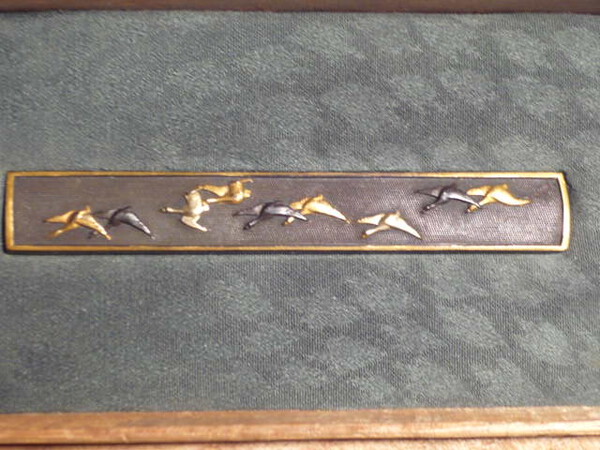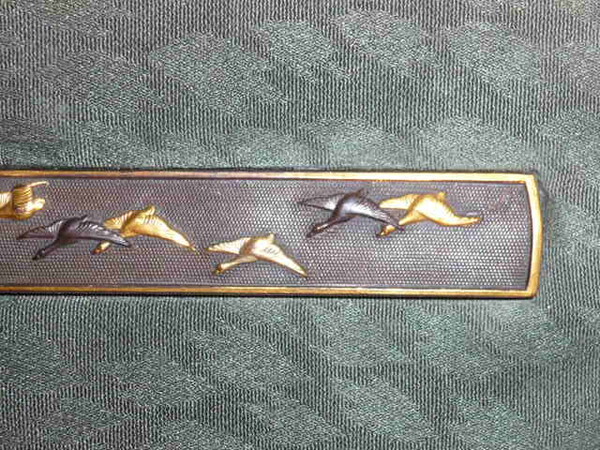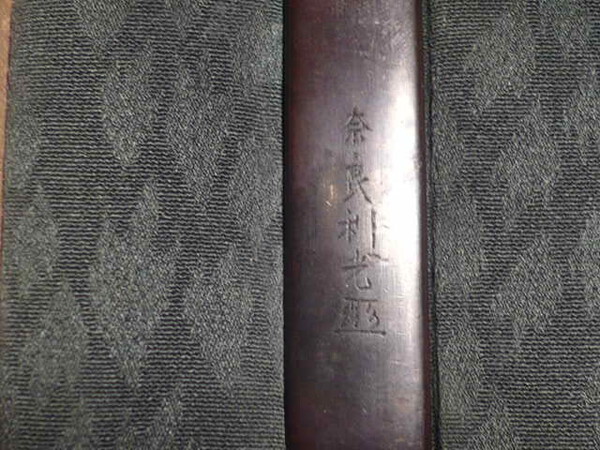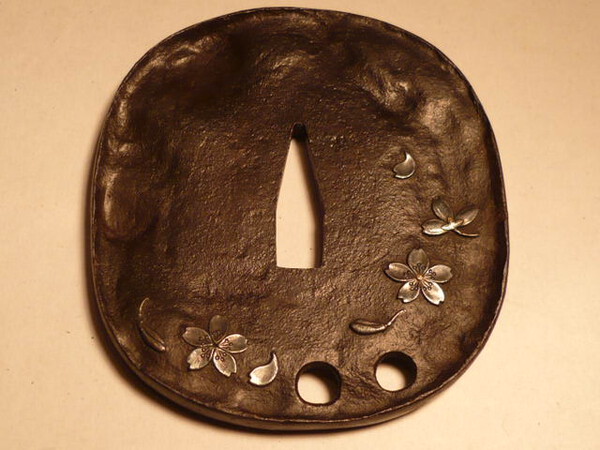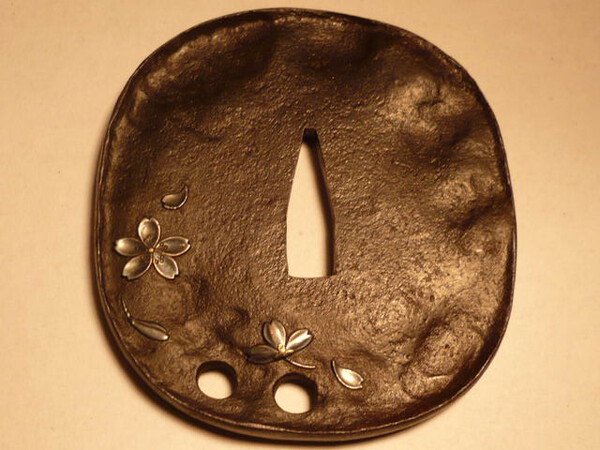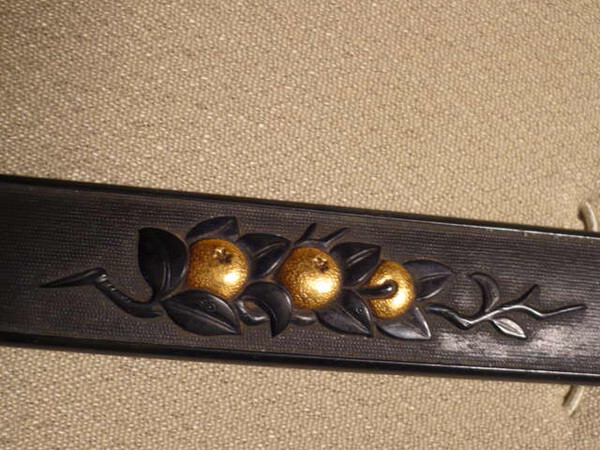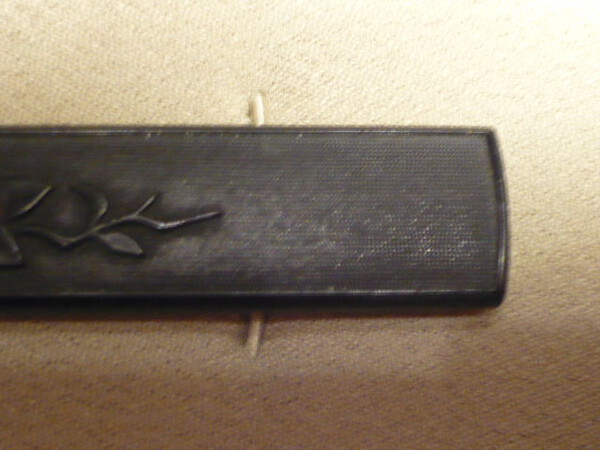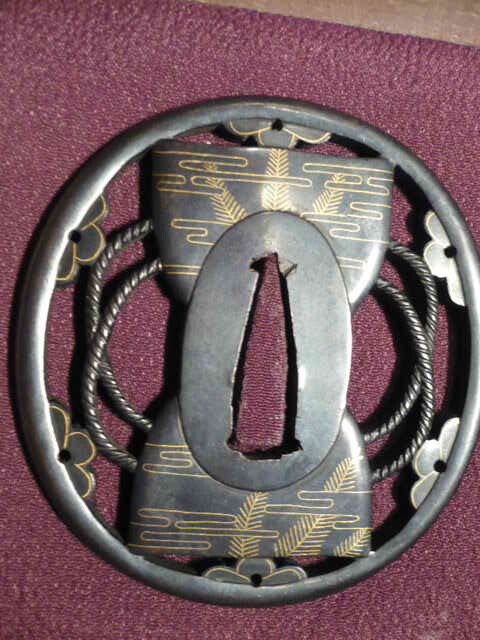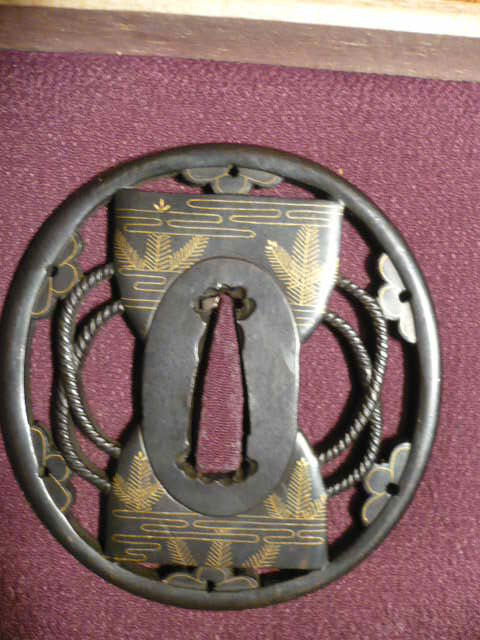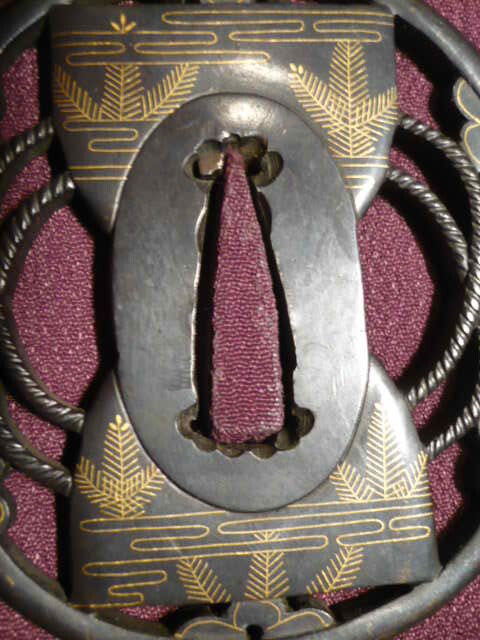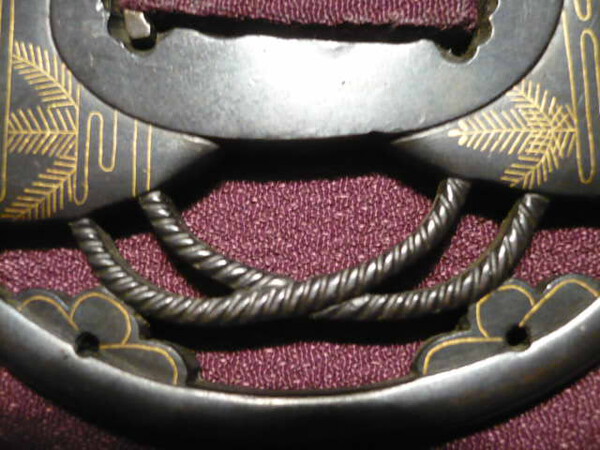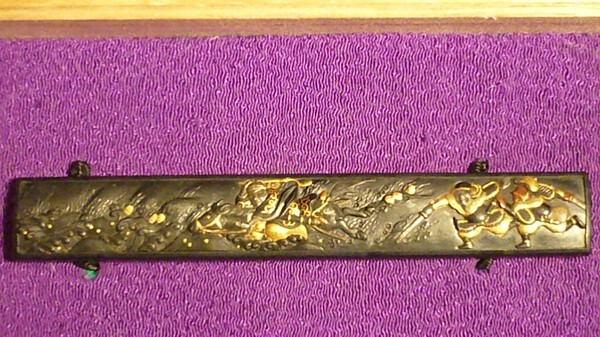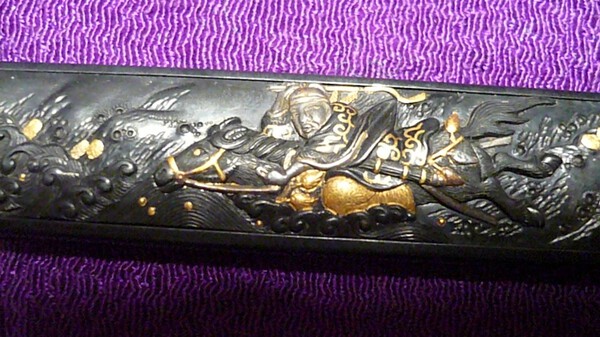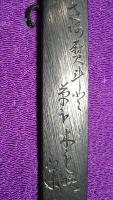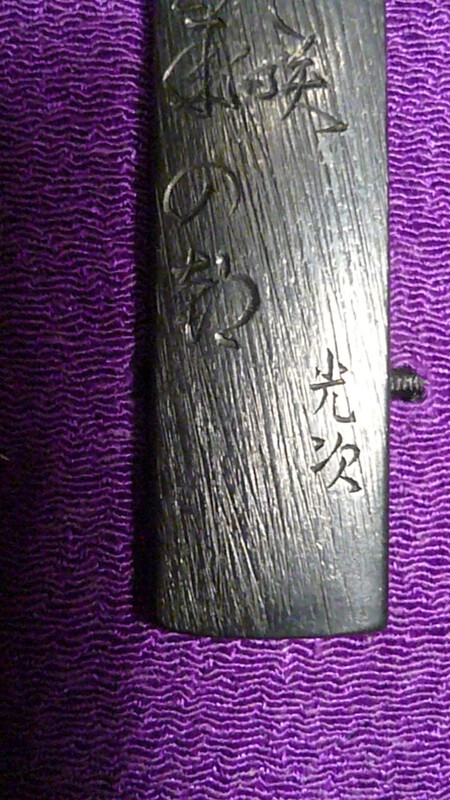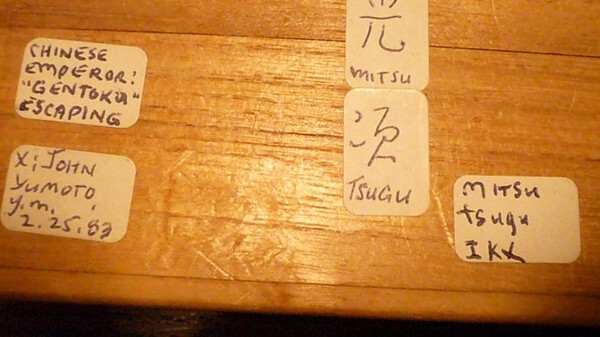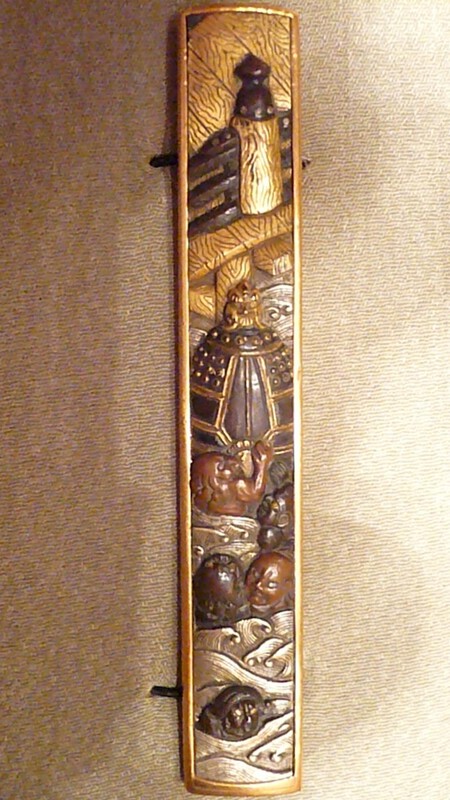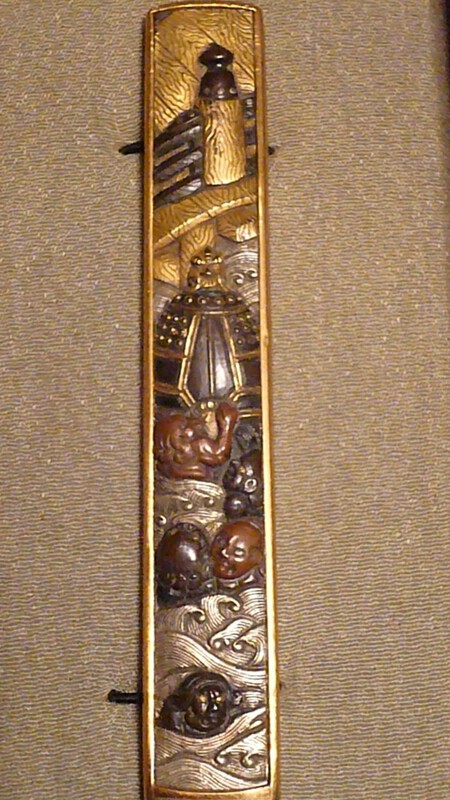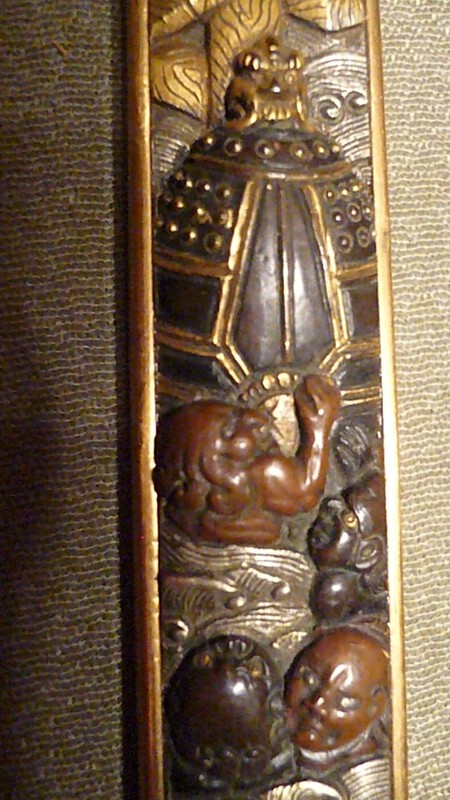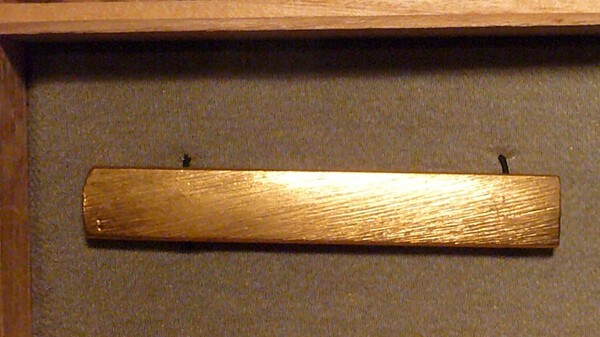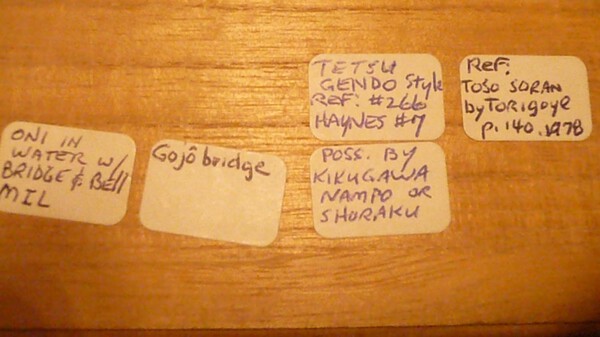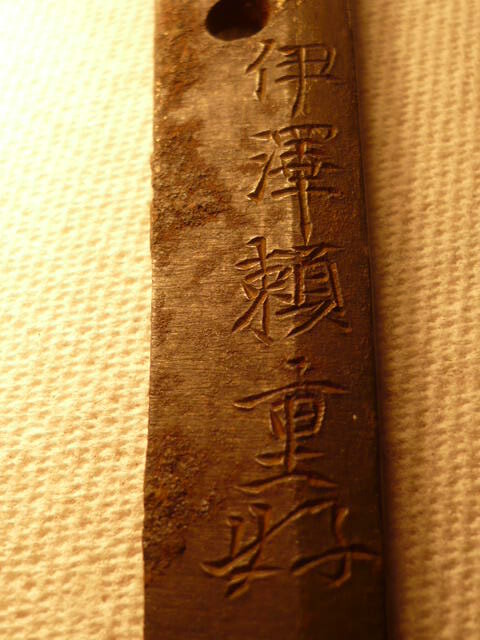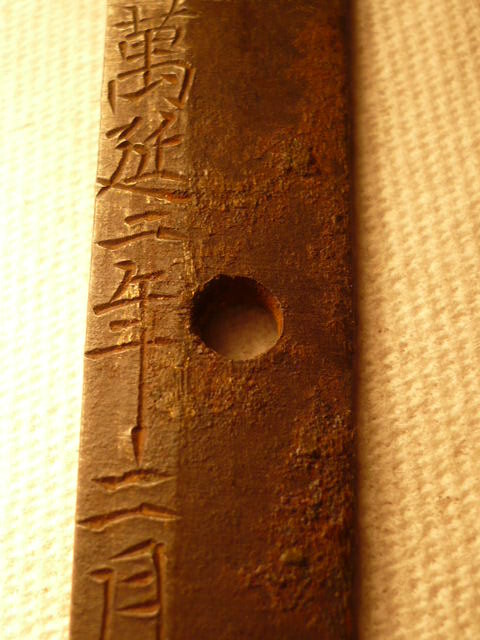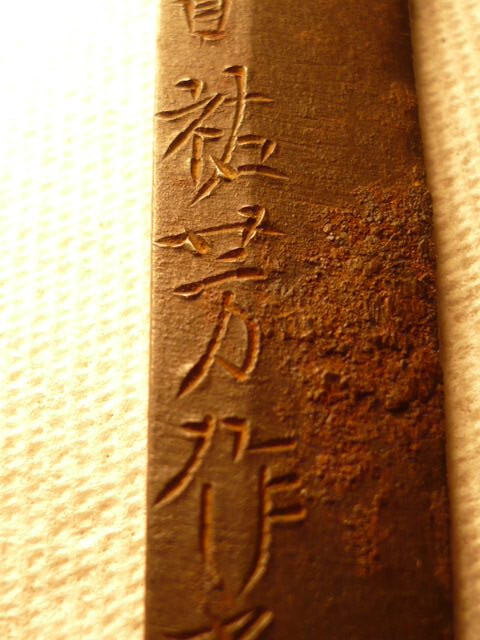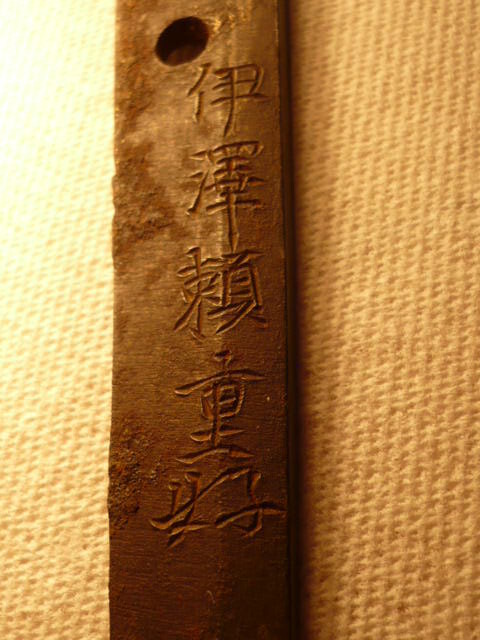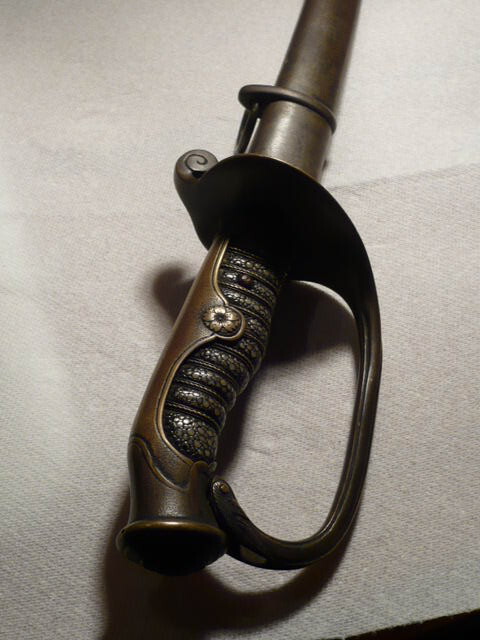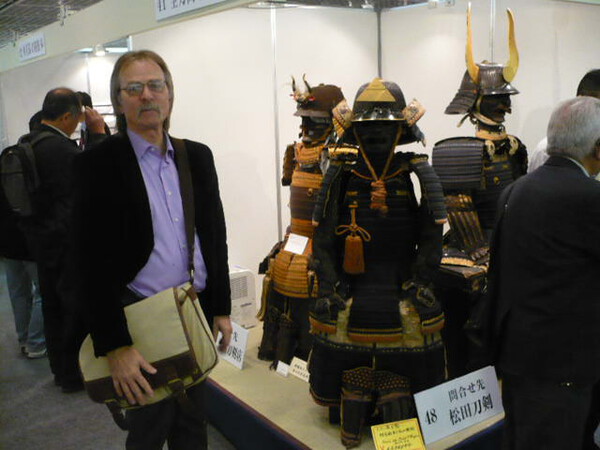
Yoshimichi
Gold Tier-
Posts
304 -
Joined
-
Last visited
-
Days Won
1
Content Type
Profiles
Forums
Events
Store
Downloads
Gallery
Everything posted by Yoshimichi
-
Translating Japanese Sword Signature Needed
Yoshimichi replied to lisalou's topic in Translation Assistance
05/05/16 10:32 p.m. Hi, The kanji looks like "Yoshimitsu" to me as well from the photos. Question: 1) Does the older sword blade measure 27 inches, in a straight line, from the point of the blade to the notch (mune-machi) on the back side of the blade where the copper-looking sleeve (the habaki) butts up against, or is it 27 inches measured from the point (kissaki) to the end of the tang (nakago)? If it measures 27 inches from point to mune-machi notch, that helps a bit in trying to sell it. The tsuba (sword guard) on the older sword looks severely rusted. By itself, I would expect it could be tough to get $40-$100 for it at a sword show. It looks like the handle (tsuka) is missing the end cap (kashira) from the photos. Is that the case? If so, it may need a re-wrap. It is hard to tell from the photos. The scabbard (saya) appears to be missing the throat piece (koiguchi), and it looks like a section of the saya material is missing (about three vertical inches in length), on the side of the saya. It looks like it might be a same' (ray skin) covered, or a material covered, saya. Again, clearer photos would really help. The blade clearly needs restoration, which is not cheap. Unless the signature can be reasonably nailed down to a bigger named Yoshimichi smith, it is likely going to be cost-prohibitive to have it professionally polished. Without seeing the blade in hand, it is hard to know if there is any serious flaws or cracks in the blade. As is, and forgetting about the signature altogether, and not having the advantage of looking at the older blade in hand, I would expect most experienced collectors/dealers are probably not going to want to offer more than around $300-$400 for the older sword, based on the photos alone. In my experience, NCO swords are pretty tough to sell for more than around $100-$250, depending on condition, with the exception of fairly rare patterns. My main market experience is in California. From your posting, I get the sense that Japanese swords are less your "antique of choice," and that in the end, you may prefer to just move these down the road to someone else, and apply the sales proceeds towards antiques of more interest to you. Perfectly understandable. If you decide to sell them, you can always list them on Ebay and see what they bring, or offer the swords for sale on this or another sword sight for a price you are comfortable with, and see if there are any takers, or take them to a sword or gun show and see what someone may offer, after they have a chance to look at the blades up close. Alternatively, you could always just enjoy them for what they are, like many of us do with some swords. Best regards, Bill E. Sheehan (Yoshimichi) -
02/17/16 8:48 p.m. Dear Peter: Nice Kozuka. It will be interesting to learn who the artist is who made it. I especially like the combination of Mt. Fuji in the distance, with the waves and the clouds. I have a small mumei mokko shaped tanto tsuba with a similar style Mt. Fuji with silver snow motif in shibuichi with a shakudo cloud, and small gold highlights. Cool find. Regards, Bill E. Sheehan (Yoshimichi)
-
02/11/16 8:54 p.m. Dear Alan: In my opinion, the mei is consistent with the Yondai (4th) generation Mishima Yoshimichi (1673). I have numeorus oshigata of the various Osaka and Mishima school Yoshimichi smiths, and my money is on the Yondai. Check out the oshigata in Imura's Shinto Taikan. We frequently see wakizashi by the 4th generation Yoshimichi. Harry Watson's Fujishiro Shinto English translation lists him as chujosaku and wazamono. It would be great if you could post some photos of the hamon (should be sudareba), and the yakidashi (the last 2-3 inches of the hamon near the hamachi. The hamon in that area tends to drop down to a narrower hamon pattern than the rest of the hamon. The nakago-jiri is correct for the Yondai, from what I can see in the other oshigata. I have a personal affinity for Mishima Yoshimichi blades. Nice find. If you email me at besheehan@aol.com, I will be happy to email you the oshigata examples I have of the Yondai Mishima Yoshimichi. Best regards, Bill E. Sheehan (Yoshimichi)
-
02/03/16 8:53 p.m. Dear NMB Members: What a top notch example of high end tosogu! Thanks for sharing. Ian: What a beautiful matching tosogu set with the shakudo, nanako, and gold cranes! How often do you see a complete matching set like this? Probably not often. Were these made for a tanto or wakizashi koshirae? One would need a pretty amazing blade to justify marrying it up with this great set, IMHO. Is there a matching tsuba that goes with this set? Well done. Regards, Bill E. Sheehan (Yoshimichi)
-
01/24/16 5:29 p.m. Dear Darcy: When someone says "High end," it is clear you and others who posted to this topic are no strangers to those words and that wonderful collecting realm. Absolutely stunning and impressive grouping of fittings! The quality we all hope to someday rise to in our collecting journey. Bravo!! Best regards, Bill E. Sheehan (Yoshimichi)
-
11/24/16 10:12 a.m. Dear NMB Members: Thanks so much for posting such great fittings examples. It is amazing to see the level of expertise and talent of the artists who created these wonderful art objects. I do not own any high end pieces, but here are a couple of pieces I am quite fond of. The kozuka is by Nara Toshimitsu. I purchased it at the 2013 DTI as a memory of my trip. The tsuba is a recent acquisition from an old collection. I find that the silver fallen cherry blossom motif subtly but effectively coveys the bushido spirit and the potentially fleeting nature of a samurai's life. Thanks for sharing your pieces. Best regards, Bill E. Sheehan (Yoshimichi)
-
01/23/16 7:15 p.m. Dear Darcy: Incredible workmanship! Certainly befitting of your tanto. Top of the mark menuki! I just saw another Awataguchi Yoshimitsu tanto on Ginza Seikodo's website with similar style koshirae: http://www.ginzaseikodo.com/yoshimitsumatsubaE.html. I am afraid to even imagine the asking price. It would make a nice companion piece to yours. Time to hit the Powerball. Best regards, Bill E. Sheehan (Yoshimichi)
-
Dear David: I have to concur with the other members that the sword in question is a non-Japanese, likely Chinese made, fake or replica sword most often seen and passed off on unsuspecting Ebay buyers as real "antique Japanese" swords. The workmanship is clearly of inferior quality, low grade, and of the type we often see being offered by Ebay sellers located in Hong Kong. The mekugi-ana (tang hole) appears drilled. The file marks on the tang look like they were done quickly and with a grinder or rasp, and the "rust" or "patina" on the tang appears to be chemically and/or heat created. The wooden "shirasaya" or storage case for the blade is not a Japanese-made shirasaya and looks like something made by an amateur or someone who is trying to make something that "sorta" look like a shirasaya, but who failed miserably. The forging in the metal that looks like "damascus" is also typical of the Hong Kong peddled "antique Japanese swords." The habaki is very poorly made, and the "kanji" or inscription on the tang is definitely nonsense as confirmed by others who have commented. It would not surprise me to learn that this sword was probably purchased by someone off of Ebay at some time in the past, and they probably learned afterward that the sword was not a real Japanese sword, and they have now consigned it to this auction to unload it. The concensus of the members is to clearly steer clear of this piece. You are better off saving a bit more money and buying a sword from a reputable sword collector or dealer from many of the websites linked through the NMB. Alternatively, try to attend some large regional gun or militaria shows, or even better, one of the Japanese sword shows listed on the websites linked on the NMB and get familiar with what a real Japanese sword looks like. At the same time, pick up a couple of basic sword books and begin to learn the basics that you will need to be able to identify a real versus fake Japanese sword. In my opinion, the learning process, the collectors you meet, and the journey ends up being the most rewarding aspect of Japanese sword collecting. Once you pick up the basics, you will be better prepared to spot the real thing at auctions, yard and estate sales, gun shows, or antique stores, and better able to spot a good buy or bargain when you see it. Let someone else waste their money on the sword being offered at this auction, and save yours for the real deal down the road. Best regards, Bill E. Sheehan (Yoshimichi)
-
U.s. Customs Paper Work, Shipping
Yoshimichi replied to nagamaki - Franco's topic in Auctions and Online Sales or Sellers
I would certainly concur with Brian and others regarding the recommendation to accurately describe and declare the value of all items on customs forms, when you are the one filling out the form, checking the boxes, and signing the customs form's declaration under penalty of perjury. A foreign seller who falsely does that does so at his/her own peril, if he/she makes a knowingly false declaration. To what extent the U.S. or Japanese governments would actually go after a foreign seller for doing so is unclear, but knowingly making a false declaration under penalty of perjury is, as we all know, a crime. I would expect it to be a crime in Japan as well. I would bet the Feds would likely not hesitate prosecuting a U.S. seller or citizen who makes a false declaration on a customs form. If one is dealing with a U.S. Customs form, then one would no doubt be committing a Federal offense, which tend to carry much longer prison sentences and much stiffer fines than violations of State laws, if convicted. I would also certainly not recommend instructing a foreign seller or anyone else to make a false declaration on a customs form, as this could potentially open that the buyer and the seller up to conspiracy charge, if the government wants go crazy and push the issue. Facing a conspiracy charge could certainly up the potential sentencing ante and risks. If a foreign seller knowingly fills out the customs form inaccurately or falsely, I would argue that this is the foreign seller's risk/problem, so long as the buyer is not in anyway involved in encouraging, instructing or asking the seller to do falsely do so. If a customs officer or government official were to ever ask the U.S. buyer what is in the package, what he/she paid for it, etc., then, of course, the buyer must and should answer those questions truthfully and with complete accuracy. From a buyer's standpoint, it would seem that all that one would expect the buyer to face is the payment of the proper and correct duty or tax on the item, presumably after the Feds investigate and make sure the buyer was not in anyway involved in the making of or encouraging of the seller to make the false declarations on the customs form. I would just consider the "red flags" and potential customs hassles the cost of transacting internationally, and the reasonable price cost of sleeping worry-free and well at night. And now, on a much less "Debbie Downer" note, here's wishing everyone a very happy and prosperous New Year! Best regards, Bill E. Sheehan (Yoshimichi) -
kozuka Seeking Information On Four Fittings- Mino Kinko/goto/kaga Kinko School?
Yoshimichi replied to Yoshimichi's topic in Tosogu
Dear Steve: Thanks so much for following up on the translation of the script kanji on the back of the Mitsutsugu kozuka, and the story or theme regarding the Gojohashi and Oni with the bell. I hope Moriyama-san or others can shed some additional light on these two pieces. By the way, I looked at the link you sent me regarding Liu Bei crossing the Tan Stream. Great link! I also checked out the additional information on Wikipedia, like you suggested. Very informative information on Liu Bei. I appreciate it. Thanks again. Regards, Bill E. Sheehan (Yoshimichi) -
kozuka Seeking Information On Four Fittings- Mino Kinko/goto/kaga Kinko School?
Yoshimichi replied to Yoshimichi's topic in Tosogu
Dear Steve: Wow! Thanks so much for all of the great information. I also really like the Oni and bell motif kozuka as well. I am looking forward to reading the episode you provided via the link. I will definitely consider submitting the Oni piece for shinsa. Thanks again, Steve. Regards, Bill E. Sheehan (Yoshimichi) -
kozuka Seeking Information On Four Fittings- Mino Kinko/goto/kaga Kinko School?
Yoshimichi replied to Yoshimichi's topic in Tosogu
Sorry. The tsuba item number on Aoi-art is number F15187. I guess it is time for stronger eyeglasses. Regards, Bill E. Sheehan -
kozuka Seeking Information On Four Fittings- Mino Kinko/goto/kaga Kinko School?
Yoshimichi replied to Yoshimichi's topic in Tosogu
Dear Members: I notice that the Aoi-art link does not connect directly to the similar tsuba listed on his website. His tsuba is listed on page one of his tsuba pages, and is listed as item number F15167. Thanks. Regards, Bill E. Sheehan (Yoshimichi) -
I recently acquired these and some other fittings from a private collector who has had these in his private collection for well over 30 years. I was very pleased to acquire them, and some will remain in my personal collection, and some will probably be offered for sale down the road...likely at next year's S.F.Token Kai. I am hoping to get some help and input from the the more knowledgeable fittings collectors of the NMB, so that I can decide which, if any, of these pieces might justify the expense of submission for shinsa (either in Tampa or in Japan). I do not want to have them papered unless they are of better than average quality, or somehow special, or unless papers are going to make a big difference in the piece's potential market value. Because I have purchased a fairly large group of pieces, at some juncture I will no doubt spin off a few of the pieces to offset the cost of other pieces I plan to keep for myself. I have attached some photos of the fittings, in hopes of getting some initial help and information from those far more knowledgeable than myself. Any information is greatly appreciated. The first is a kozuka with what appears to be a gold persimmon (?) motif, in shakudo and with nanako. In looking on line and at my own limited fittings resources, I am thinking Mino Kinko, but I am wondering if this could possibly be a Goto line piece? The next is a shakudo and gold inlay tsuba with water and pine needle (?) motif. Aoi-Art has one listed on their website that is a very similar piece, but with a different inlay design. http://www.aoijapan.com/tsuba-mumei-kaga. Similarmotif pieces I have seen seem to bring higher than average asking prices on various websites. Aoi-art lists this piece as Kaga Kinko school. Is this part of a Goto school line? This piece was never mounted, as best I can tell. It is a bit larger than the one on Aoi-art. I am wondering if this might be a good shinsa candidate? The next is a really nice shakudo kozuka with Chinese Emperor Gentoku being chased through water and escaping some other riders. There is writing on the back of the kozuka that I would really like to have translated, if anyone is inclined and can do so. The signature is listed as "Mitsutsugu." The piece was purchased personally from John Yumoto in 1983. Can anyone tell me what school "Mitsutsugu" was from, and how he ranks as a fittings artist? The workmanship on this piece is really above average, in my opinion. The last is a really incredible kozuka depicting Oni stealing a bell and crossing a river. The relief on the piece is very high and detailed. I have not tested it, nor would I, but I cannot tell if the backing is solid gold or gold washed. I have attached a photo of the fitting's box lid with the information the previous owner had obtained. I have no idea what school of fittings artists this piece would be from. Any ideas? If one were to shinsa any of these pieces, any opinions as to which, if any, would most benefit from or justify the expense of a shinsa (NTHK or NBTHK)? Any assistance or information is greatly appreciated. Regards, Bill E. Sheehan (Yoshimichi)
-
D T I 2015
Yoshimichi replied to Guido's topic in Sword Shows, Events, Community News and Legislation Issues
I second that request, Brian. Those of us who could not make the DTI this year would love to see any photos the members and attendees can post. The only photos I have seen so far are those posted right now by Mike Yamazaki on his tetsugendo face book. Thanks for the photos, Mike. Keep the photos coming. They are appreciated. It's great to see our fellow collectors and the great pieces available at the show. Regards, Bill E. Sheehan (Yoshimichi) -
Dear Guido: Thanks for correcting my taxi cab fare errors. It must have seemed cheaper to me at the time, given that I was bleeding so much money on everything else. Great detail on how the fares work, especially after 11:00 p.m. It definitely helps to get familiar with the subways and local trains. Regards, Bill E. Sheehan (Yoshimichi)
-
Dear Steve and Greg: Glad I could help. As Jean mentioned, Robert Hughes lives in Kamakura, and has lived in Japan for a number of years. He has a booth at the DTI, and he is always willing to help foreign visitors when he can at the show. He is completely fluent in Japanese. When at the DTI, I would recommend stopping by his booth. Robert organizes the Yakatabune Dinner Cruise the first night of the DTI. It is a real blast, and the views of Tokyo at night from the Bay, atop the cruise boats balcony area, are incredible. A lot of fun, food, and refreshments for all. Well worth the cost. I forgot to mention. I try to coordinate my itinerary to include being in Tokyo on November 3rd, when possible. That is the day of the celebration at the Meiji Shrine of Emperor Meiji's birthday. The Meiji Shrine puts on Kyudo (archery), iaido, and other martial arts demonstrations that day. The highlight is the Yabusame (horse-mounted archery) competition where competitors dressed in traditional samurai style attire thunder down a long path on horseback while attempting to shoot three targets with an arrow in a matter of about 15 seconds. Local parents of young children dress them up in traditional kimono's and edo period attire, and it is a great opportunity to take photos and see some really wonderful sights. If you visit the NBTHK sword museum, Aoi-Arts sword shop is just around the corner, about a 5-10 minute walk. The NBTHK Museum is about a 20 minute easy walk to the Meiji Shrine. The museum is closed on Emperor Meiji's birthday, at least it was the day I was there. If you are not going to do Japan solo, and if your wife or girlfriend are not all that into walking all over the place, which is what you do, consider occasionally taking a taxi to some of your local sights. It will save their feet and keep everyone happy. Comfortable, good shoes are a must. Blisters could potentially ruin the trip for someone. Taxis charge about $7.50 automatically when they drop the meter flag, but it will take you about 10 miles before the meter starts adding additional money to the meter. Also, the subways and local trains are a very cheap way to travel, a cool way to observe the locals, and not too hard to get the hang of. As with many situations, I found that "cash is king" in Japan. I have found Sellers at shows, the DTI and at flea markets willing to negotiate and discount there asking price on items to at least some extent, if you politely make the offer. Most hotels have someone who speaks English, and most of the younger Japanese can speak enough English to get you what you need. The farther you get away from Tokyo, such as in places around Kyoto, the more it helps to speak a few basic Japanese phrases. Hopefully, other NMB members can give you some tips on what they have learned and picked up along the way in their travels. They helped me immensely the first time I went over. Have a great trip! Regards, Bill E. Sheehan (yoshimichi)
-
Dear Steve: Glad to hear you are thinking about taking a trip over to Japan. This is a "must do" for any fan of Japanese history/culture and nihonto. I have been fortunate enough to travel over to Japan four times, the last time being last year. There are a lot of collectors on the NMB who have traveled over, and I am sure they would be happy to give you any tips they may have picked up in their travels. I usually go for 7-9 days per trip, and I am able to see and travel to all kinds of places in Japan. Fall is a wonderful time to travel in Japan. The weather is usually very pleasant, and the best annual sword show (DTI) is held in Tokyo every Fall (usually late October, early November). If there is anyway to plan your trip to coincide with the Dai Token Ichi sword show, you will see some of the best swords and fitting in one location, and have a ball. Here are some things that I would recommend: 1. Book your flight as early in the year as possible. (If I am going in October, I usually try to book by around April or May at the latest). 2. Purchase a rail pass voucher, if you plan on doing any independent travel outside of Tokyo to places like Himeji Castle, Kyoto, Hakone, Nikko or Matsumoto Castle. If you can afford the extra expense, get a first class (Green car) voucher. You cannot purchase a rail pass in Japan. You have to purchase a voucher outside of Japan (JR Rail Pass website), take the voucher with you into Japan, and then exchange the voucher at the airport for the actual rail pass itself. It is a bargain for foreigners who plan to do a lot of traveling while in Japan. 3. Stay at the best hotel you can comfortably afford. I believe the hotel can make or break a trip, especially if you are taking your spouse or girlfriend. There are lot of great hotels in Tokyo (Keio Plaza, Hilton), and a number of others that NMB members can direct you to and recommend. Book early in the year for the best prices, and follow them throughout the year thereafter, to possibly spot a better rate as they change and have promotions. 4. You may want to include a one or two one day guided bus tour excursions into the itinerary for the first time over. It lets you see the most popular places, and they usually include lunch and an English speaking Japanese tour guide. Those can be found through Sunrise Tours and Japanican.com. They do day trips to Mt. Fuji, Nikko, Hakone, Kyoto, and a number of other places. 5. I would definitely try to make it to Kyoto, if you can. I would recommend Kiyomizu-dera, Nijo Castle, the Golden Pavilion and the Silver Pavilion, the Gion Geisha district, and the Kitano Tenmangu Shrine (One of the best flea markets I have been to in Japan...held the 25th of each month). They offer one and two day excursions from Tokyo to Kyoto. Otherwise, just jump the bullet train in Tokyo and you will be there in about 2.5 hours. I stay at the Kyoto Tokyu Hotel when in Kyoto. It is reasonably priced, and close to everything). 6. In and around Tokyo is the Yasukuni Shrine (Great Sunday flea market) and incredible war artifacts at the museum. Also, Ueno Park and Zoo where the Tokyo National Museum is at. Sengaku-ji (47 Ronin Graves), The Meiji Shrine, the Ginza, the NBTHK sword museum, Japanese sword dealer's shops, and so many other great places. 7. Castles: I would highly recommend Matsumoto Castle, Himeji Castle, and Nijo Castle. Hakone Castle is also pretty cool, but Himeji and Matsumoto are outstanding. Matsumoto has an incredible matchlock and armor collection. 8. Nikko: Nikko is a must see. Tokugawa is enshrined their, and it is the most incredible place in the Fall. My wife, son, and our friends loved Nikko last year, They all want to go back. Well worth traveling by train for the day, or taking a guided day trip. The guided day trip usually includes Kegan Falls and Lake Chikuzen. I did that the first trip over, and it was really memorable. 9. Use www.hyperdia.com to help plan travel times between various towns by train, bus, etc. 10. If you can pick up any basic Japanese phrases before you go, it really helps. If you are the type that can learn a language from an audio CD, one that worked great for me was "Drive Time Japanese" and "InFlight Japanese" by Learning Language. The CDs are usually available at Barnes & Noble. Two books I would highly recommend you read before going over and take with you are "DK Eyewitness Travel Japan," and "Japan Made Easy" by Boye Lafayette De Mente. I bought my copies at Barnes & Noble. 11. Type up an itinerary and check list of things to take over and to purchase in Japan on the trip. Also, buy some "make your own" business cards at Office Depot or the like, and type up address locations of places and locations you want to go on individual cards, including your hotel addresses, so that you can show those to Taxi drivers, which will get you to where you want to go, especially if you do not speak Japanese. Make a set for your spouse or girlfriend as well. There are a number of NMB members who travel over almost every year to Japan that I am sure would be happy to also give you their input. Robert Hughes (hughes@keichodo.com), Fred Weissberg (www.nihonto.com), and Andrew Quirt tend to go over quite frequently. I plan to go over again next year. Maybe we will cross paths along the way. Have a great trip. Best Regards, Bill E. Sheehan (Yoshimichi)
-
Dear Marcello: When I collected Yoshimichi school blades, I put together a binder with copies of every oshigata I could find of the various generations of the Mishina and Osaka shinto line smiths who signed "Tamba no Kami Yoshimichi." In comparing your mei to the oshigata examples that I have, yours appears to have the most characteristics of the mei/kanji examples of the Shodai (1st generation) Mishina line smith. Although the "Tan" kanji does not have the classic deeply curved " bow" look to it that he is known for, if it is not gimei, and looking at just the kanji only, my vote would probably be for the Mishina line shodai smith. It would be great to see some photos of the blade and hamon. Obviously, the mei alone is not enough to accurately assess the sword, but it is certainly a start. This line of swordsmiths is known for rather distinct characteristics, like the hamon style, yakidashi, etc. and someone will likely need to see the blade in hand to give you a better feel for which smith may have made the sword. As a start though, I believe Imura's Shinto Taikan might have a number of "Tamba no kami Yoshimichi" oshigata for comparison. This would probably be a good sword to bring to the S.F. Token Kai to get some input from those more knowledgable than I, if you are planning to attend. Ultimately, your best bet is to probably just submit it for shinsa and see what the NBTHK or NTHK experts say, assuming you are planning to keep it. Good luck on the research. Regards, Bill E.Sheehan (Yoshimichi)
-
Dear Members: I found this Kyu gunto wakizashi this weekend in a pawn shop in Crescent City, CA. I am having trouble translating the last kanji in the smith's name (sada, yoshi, waka, fusa?), and I can only translate about two characters on the opposite side of the nakago. I think two of the characters on that side are "I" and "Shige." I am not sure if this is an owner's name, more information about the smith or his town, or some invocation of some sort. I think the mei side says "One luck day in February, in the second year of Man-en (1860), Suke ____(?) made this." I presume the year is 1861 or 1862. I would greatly appreciate any help in confirming if I am correct in what I have been able to translate so far, and what the smith's name actually is: Suke ______(?), and any information on this smith. At first I thought maybe "Sukeyoshi," but the mei does not really match the one pictured in Fujishiro, so maybe gimei, or a bad translation on my part. I have attached some photos of the mei and handle. Thanks for any help. Regards, Bill E. Sheehan (Yoshimichi)
-
Hi Curtis: I agree with the other members of the forum regarding the value of the items you were asked to sell for your friend. All of the tsuba appear to be in fairly poor condition, and most serious collectors would pass on them. Unless these were priced very cheaply (dirt cheap) at a show, I think most of us would be hard-pressed to sell them for what you were able to sell them for. All appear to be simply "filler" tsubas for low end swords missing a tsuba. This topic raises a more important issue: What should one do to protect oneself when asked to sell an item for someone else, so as to avoid any "misunderstandings" or consignor's/owner's remorse after the item is sold, and any potential legal ramifications? Many of us have been asked by friends, or persons referred to us by others, to help sell items for them. It is not uncommon at sword shows, gunshows and on websites to hear or see someone indicating that an item offered for sale is being sold by the seller "on consignment." As one who has sold items on consignment for others in the past, and as an attorney, I try to make it a practice to put it in writing, signed by both parties, setting forth exactly what the consignor/owner will accept/receive at a minimum from the sale proceeds for each item sold to avoid any post-sale complaints/remorse, misunderstandings, ill-feelings, or sleepless nights. This is even more important when the fair and current market value of the item or items consigned are, say, worth more than $1,000. Additionally, the more inexperienced the person is who is asking you to sell an item for them, and the more experienced you are with regard to knowing or purporting to know the fair market value of the item(s), the more likely it is that you may be accused of mishandling the sale, or underselling the items, if a lawsuit ensues, and if you do not have something in writing setting forth what the parties agreed to before the items were sold. We have all heard stories of someone who knew virtually nothing about the fair market value of swords or sword fittings/collectibles, who consigned them to someone else to sell, and then after the items were sold claimed they were somehow ripped of by the person who sold the item for them. To avoid a number of problems after the sale, my preference and recommendation would be to get something in writing, setting forth and describing the item(s) being consigned/sold, a reasonable description (pictures would be helpful), and setting forth exactly how much the seller will receive from the sale proceeds for each item. When I first started collecting nihonto in my 20's (early 70's), I took around $10,000 worth of swords on consignment from a Los Angeles causal acquantance/collector. I was going to show them to a friend of mine in Northern California, and possibly receive one of th swords aout of the deal if it went forward. I had the items stored in a guncase in a closet. My house was burglarized by some neighborhood kids, and thank goodness they only took on eof my tantos, some money, and a new baseball glove(definitely, kids). Fortunately for me, they never looked in the closet in the very room where they found the other items, as the swords were in that closet. At the time, I had nothing in writing between myself and the L.A. owner of the consigned swords, describing the items, their individual values, etc., or what arrangements I had with regard to the swords. Had they been stolen, I would have arguably been faced with squaring up with the owner, and without having something in writing, it could have gotten very ugly and finacially expensive. Since that time, I have made it a practice to get something in writing. The writing memoralizing the consignment arrangement probably does not have to be prepared by a lawyer and all encompassing, but one would hope that it would at least include the name of the owner/seller of the items listed, the name of the person selling the items for the owner, a description of the item(s) being sold, an agreed upon estimated value of the items(s), the amount the owner/seller agrees to accept/receive for each item, and the date and signatures of both parties to the agreement. This simply protects both parties, and could help if an insurance claim must be made down the road relating to the items (items are stolen, lost in transit, damaged). Just a suggestion for future transactions. As to this latest transaction, like all of the other forum members who commented, I think you worked miracles getting $550 for this grouping of tsubas. Good job.Thanks for the topic, Curtis. Regards, Bill E. Sheehan (Yoshimichi)
-
Tokyo report
Yoshimichi replied to Jean's topic in Sword Shows, Events, Community News and Legislation Issues
Brian: No problem at all with the airlines bringing the poles back to the U.S. I flew on United Airlines through SFO from Chico, CA. The pole lengths were about 52 inches each without the blade. I suppose it might be a problem with a 7' or 8' pole, but I haven't tried that (yet). I obtained a square packing box from the hotel and some packing tape, and fashioned a three-sided long shipping tube out of it (Western "Origami"). The box was 400 yen, and the hotel supplied the tape and scissors for free, and even made a string carry handle for the box. I took some extra luggage tags over with me, and I through one on the yari box. The overall length of the box, when packed, was about 60 inches long by about 8 inches wide on alll three sides. I usually take a small role of the smaller bubble wrap and a roll of strapping tape with me in my check in bag when I travel to Japan, knowing that I will be buying something. The two dealers at the show wrapped the poles for me in paper and bubble wrap at no cost right at the DTI. The yari poles just had to be checked in at the oversized luggage counter at Narita Airport. They arrived safely at SFO without damage. I had to then recheck them at SFO for the SFO to Chico leg of the flight, and they arrives with no problem in Chico as well, along with my other checked luggage. It's nice to be able to purchase something and bring it back with you on the return trip. The yari blades were both under 5.50 inches in length, so I just threw those into my check in suit case wrapped in bubble wrap. No problems whatsoever going through customs on either end. I brought back a smaller jumonji yari with pole the same way two years ago that I purchased at the DTI for about $450. The dealer for the jumonji yari packed the yari pole up in a box for me to take on the plane at no cost on that occasion. The dealers have been extremely willing and happy to help package things up. There are usually two or three shorter poled yaris for sale at the DTI each year. I suppose one could probably bring back a yumi or arrows, or koshirae this way as well. Does anyone know if one can purchase a matchlock in Japan and bring it back with them, or do those also have to go through a clearance/waiting period process in Japan before they can leave the country, like swords? Regards, Bill E. Sheehan (Yoshimichi) -
Tokyo report
Yoshimichi replied to Jean's topic in Sword Shows, Events, Community News and Legislation Issues
I had the pleasure of attending the DTI this year. There were some really incredible fittings and swords on display and for sale, as always. One dealer must have had 40-50 yari and pole arms for sale, most complete with poles. There were a lot of matchlocks for sale, but they seemed to be priced fairly high compared to what one can normally purchase them for in the U.S. They had some great large bore guns. This year my family and a couple of good friends went with me to Japan for the first time, so I played "tour guide." As such, I was only able to attend the DTI the last day from about 10:00 a.m. to 12:30 p.m., but I was still able to pick up some very reasonably priced items. I purchased two yari complete with poles, one for $800, and another for $400. The dealers were definitely willing to discount their asking prices the last day. The $800 yari was originally priced at $1,200. One does not need a ton of money (though it could certainly help) to purchase some nice things to add to ones collection from the DTI. For those members who have not yet had the opportunity to make a trip over to Japan, I would highly recommend it, along with a rail pass (what a bargain!). One can easily take a number of one day trips away from Tokyo and see such great places as Matsumoto Castle, Himeji Castle, Nikko, Hakone-Fuji, and Kyoto, hit some flea markets, and see many places in and around Tokyo in just a mere 7-9 day trip. Thanks to all of the NMB members who posted pictures of this year's DTI. It was great seeing them. Great to see Robert Hughes and some other NMB members at the DTI as well. I have added a couple of pictures I took at the show. Regards, Bill E. Sheehan (Yoshimichi) -
Bishu Osafune Sukesada (orikaeshi-mei)-Shinsa candidate?
Yoshimichi replied to Yoshimichi's topic in Nihonto
Gentlemen: Thanks so much for the input on this one. I appreciate it. I will definitely study it further between now and August, and bring it with me to the S. F. Token Kai this year for a "hands on"assessment of where to go with this one. Thanks, everyone. Regards, Bill E. Sheehan (Yoshimichi)


